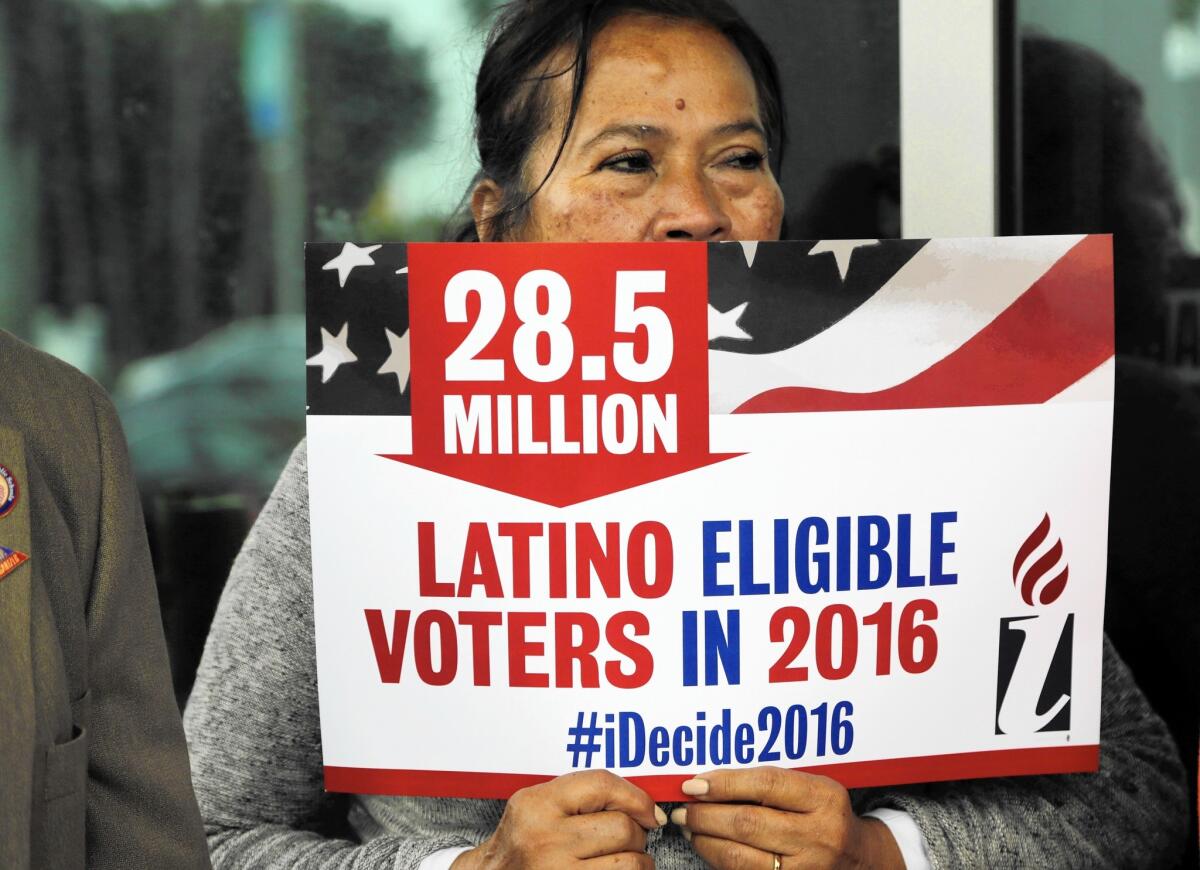Op-Ed: How to register Latino voters

Georgina Arcienegas holds a sign in support of Latino voters during a protest outside the office of Florida Rep. Carlos Trujillo, Tuesday, Jan. 12, 2016, in Doral, Fla.
- Share via
The Spanish-language channel Univision hopes to register 3 million new Latino voters before the November election. The organization Voto Latino is sending volunteers to Maná and Los Tigres del Norte concerts with an app that scans driver’s licenses and quickly registers new voters. The National Council of La Raza and the League of United Latin American Citizens are once again staffing their long-running registration campaigns.
It’s no secret why: “The rule is no one can make it to the White House without the Hispanic vote,” said Univision anchor Jorge Ramos.
In the 1992 presidential election, Latinos cast 4.2 million votes. By 2012, that number had nearly tripled, to 11.2 million. Now the Pew Research Center estimates that between 2012 and November 2016, 3.2 million U.S.-born Latino citizens will turn 18 and be eligible to vote; another 1.2 million Latino immigrants will become naturalized citizens.
One of the most successful voter registration drives among Latinos occurred in East Los Angeles nearly 70 years ago.
These numbers, however, obscure another trend: Since 1992, voter registration rates among Latinos have remained stuck at around 58%. By comparison, about three-quarters of whites and blacks are registered voters. This is crucial, because once Latinos register, they vote. About 82% of registered Latino voters went to the polls in 2012, just five points below the turnout of white registered voters.
“The principal problem is not voter turnout,” concluded a January report published by CNN en Español and the Center for Latin American, Caribbean and Latino Studies at City University of New York. The report’s author, Laird Bergad, didn’t see signs the registration rate would improve: “There is no reason to believe that this will change substantially by 2016, despite many announced voter registration drives.”
Of course, that was before Donald Trump emerged as the Republican front-runner. His candidacy alone may increase Latino voter registration this year. But to seal Trump’s fate, and to change the trajectory Bergad documented, Univision, Voto Latino and the other groups should look closely at history. One of the most successful voter registration drives among Latinos occurred in East Los Angeles nearly 70 years ago.
In 1947, a Mexican American social worker named Edward Roybal ran for Los Angeles City Council seeking to represent the 9th District, which included Boyle Heights and downtown. About a third of the district’s residents were Latino, Roybal’s natural base. They were eligible to vote, but few were registered. Roybal finished third in a field of five, winning less than half the votes of incumbent Parley Christensen.
After the election, Roybal crossed paths with a community organizer, Fred Ross, who worked for Saul Alinksy. Roybal and Ross formed the Community Service Organization in Boyle Heights, tackling neighborhood issues such as police brutality and evictions. Voter registration was at the center of their work.
By the time Roybal ran for City Council again in 1949, the CSO had turned Latinos into a powerful political force. Roybal trounced Christensen in the 9th District, winning more votes in Boyle Heights alone (12,684) than his opponent did in the entire district (11,948). Roybal’s final tally — 20,562 votes — was a sixfold increase from two years earlier. He became the first Spanish speaker on the City Council since 1881.
The key to the CSO’s success was a bottom up, face to face, community-based campaign. Ross recruited volunteers who spent night after night knocking on doors. They hosted organizing meetings in their living rooms, where newcomers were signed up to host the next meeting, inviting more friends and family members. “We can ... we will ... we must vote!” read one CSO flyer.
Ross kept a 3x5 index card for each registered voter with a Spanish surname. The collection grew to more than 10,000. He tallied who was bringing in the most voters, male or female volunteers. The local newspaper, El Pueblo, reported the results: Three women registered more than 500 voters apiece, but no one could touch Matt “Cyclone” Arguijos: 2,286 registered voters.
The success in 1949 proved to be repeatable. In 1968, Ross worked with volunteers from the United Farm Workers on another East L.A. registration drive. They signed up 11,000 voters in 20 days in support of Robert F. Kennedy’s presidential campaign. One of those UFW volunteers was Marshall Ganz, who would later help develop Barack Obama’s 2008 field campaign.
“That was my school,” Ganz says of Ross’ East L.A. efforts. “That has always been my basic point of reference for how you do grass-roots political work.” It’s not the number of paid canvassers that matters most, Ganz adds, but “recruiting people from the community to do the work.”
Canvassing Maná fans at the Forum, and recruiting celebrities for PSAs, can’t hurt in 2016. But Roybal and Ross’ success in Boyle Heights lends credence to common sense: To empower Latinos, the community is key. It’s great to be able to tap a screen to register to vote. It’s even better to mobilize a neighborhood to knock on doors, app in hand, until someone answers.
Gabriel Thompson is the author of the just-published “America’s Social Arsonist: Fred Ross and Grassroots Organizing in the 20th Century.”
Follow the Opinion section on Twitter @latimesopinion and Facebook
More to Read
A cure for the common opinion
Get thought-provoking perspectives with our weekly newsletter.
You may occasionally receive promotional content from the Los Angeles Times.










